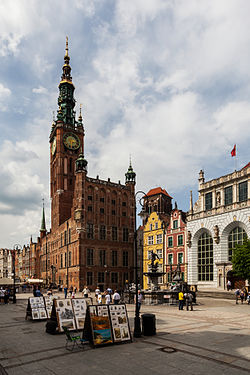Gdańsk Town Hall
| Gdańsk Town Hall | |
|---|---|
Ratusz Głównego Miasta w Gdańsku | |
 Main Town Hall in Gdańsk | |
 | |
| General information | |
| Type | Town hall |
| Architectural style | Renaissance-Baroque |
| Location | Gdańsk, Poland |
| Construction started | 1346 |
| Completed | 15th century |
| Height | 83.45 metres |
| Historical Museum of the City of Gdańsk | |
Historic Monument of Poland | |
| Designated | 1994-09-08 |
| Part of | Gdańsk – city within the 17th-century fortifications |
| Reference no. | M.P. 1994 nr 50 poz. 415[1] |
Gdańsk Main Town Hall is a historic Ratusz located in the Gdańsk Main City borough of Śródmieście. It is one of the finest examples of the Gothic-Renaissance historic buildings in the city, built at the intersection of Ulica Długa and Długi Targ, in the most popular part of Gdańsk.[2] The Main Town Hall in Gdańsk houses the History Museum of the City of Gdańsk.[3]
Location
The Main Town Hall in Gdańsk is located on Ulica Długa, part of the Royal Route. The building is located in the building complex, surrounded by Ulica Długa, Kramarska Street, Piwna Street, and Kaletnicza Street, located at the corner of the first two. The building is the second highest building in the Main City (after St. Mary's Church), and is in the most notable part of Śródmieście in Gdańsk. Access to the building by car is difficult, as Ulica Długa is pedestrianised all year around. The public transport does not reach the building. The closest tram stop is located at Podwale Przedmiejskie.[4]
History

The oldest fragments of the town hall come from 1327 to 1336 - the building was then much smaller in size, which led to its expansion in the subsequent years. In the fourteenth-century the
The first major expansion of the building began in 1378, after the full Kulm law was given to the city. The expansion of the building was led by Henryk Ungerdin, and the reconstruction was complete in 1382. Between 1454 and 1457, with the relation of the arrival of King Casimir IV Jagiellon, the town hall was expanded. The town hall's tower was complete in the years of 1486-1488; the building of which was led by Henryk Hetzel. The tower was completed by Michał Enkinger, with a high dome in 1492, which had burnt down in 1494. In 1504, the town hall was visited by King Alexander Jagiellon.[6]
After a fire in 1556, the town hall was rebuilt and expanded with Renaissance influences by Dutch architects and master-builders, including Wilhem van den Meer, Dirk Daniels, and Anthonis van Obbergen.[7] In 1561, a gilded statue of the then reigning Polish King Sigismund II Augustus was placed at the top of the tower and a carillon was installed in the tower.[8]
Heavily damaged in WW2, with the loss of the top of the tower, it was carefully repaired and reconstructed, largely complete by 1952.
Gallery
-
Sundial
-
Statue of King Sigismund II Augustus at the top of the tower
-
White Room
-
Red Room
-
Spiral stairs
References
- ^ Zarządzenie Prezydenta Rzeczypospolitej Polskiej z dnia 8 września 1994 r. w sprawie uznania za pomnik historii., M.P. z 1994 r. Nr 50, poz. 415
- ^ "Main Town Hall In Gdańsk". MHMG. Archived from the original on 6 March 2016. Retrieved 10 March 2016.
- ISBN 8373414029.)
{{cite book}}: CS1 maint: multiple names: authors list (link - ISBN 978-8391607879.)
{{cite book}}: CS1 maint: multiple names: authors list (link - ISBN 9788360887356.)
{{cite book}}: CS1 maint: multiple names: authors list (link - ISBN 8321722946.
- ISSN 0001-6829and also in the author's collection of essays Baltic Commerce and Urban Society, 1500-1700: Gdańsk/Danzig and its Polish Context (Adlershot, UK: Ashgate, 2003)
- ^ "Ratusz Głównego Miasta". Muzeum Historyczne Miasta Gdańska (in Polish). Archived from the original on 14 March 2016.
- Muzeum Historyczne Miasta Gdańska (2016), Ratusz Głównego Miasta. History. Visitor information.





